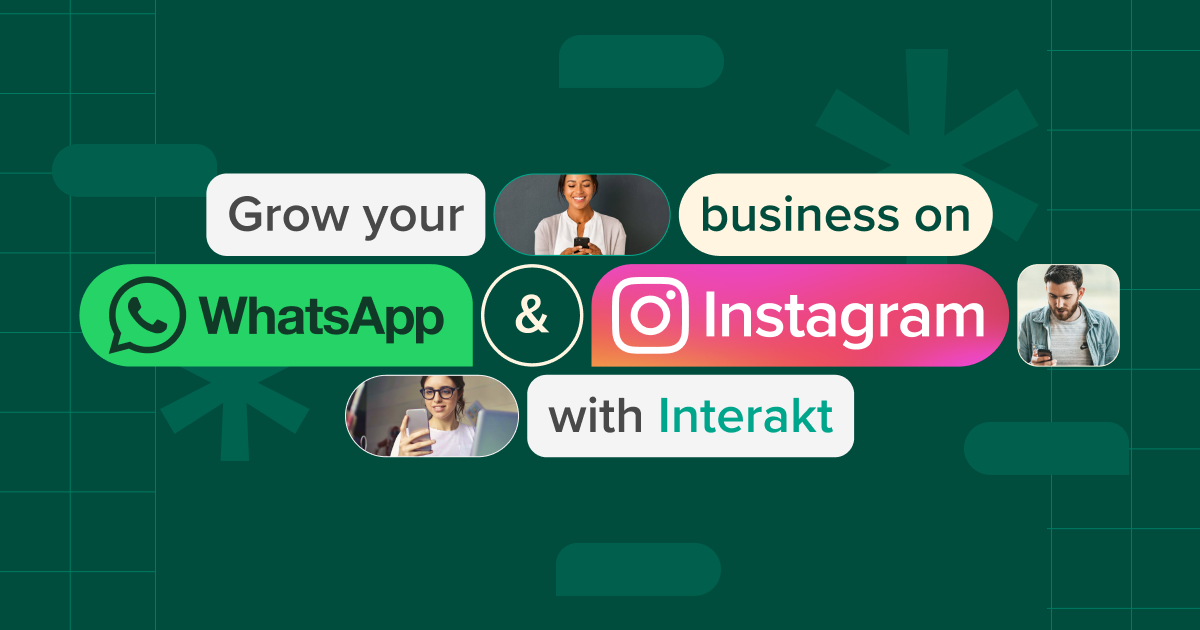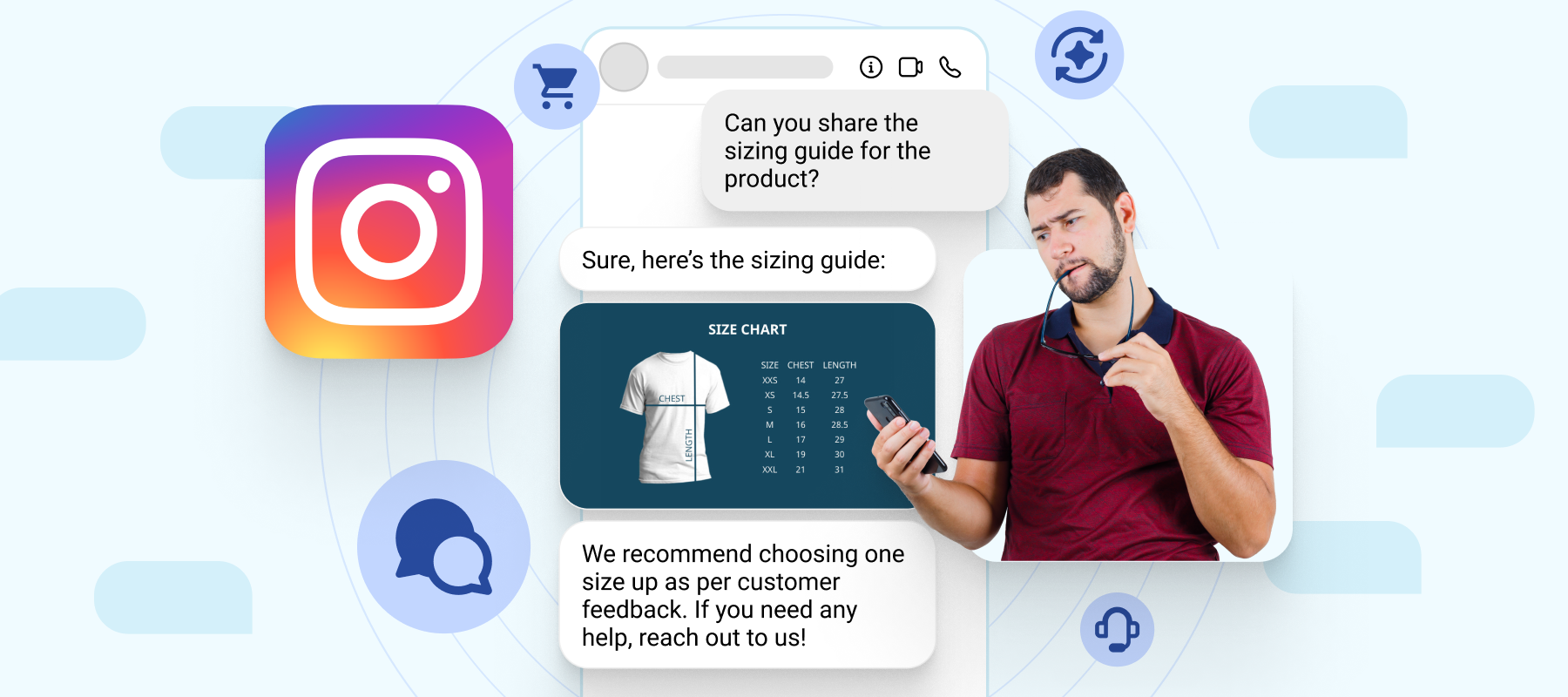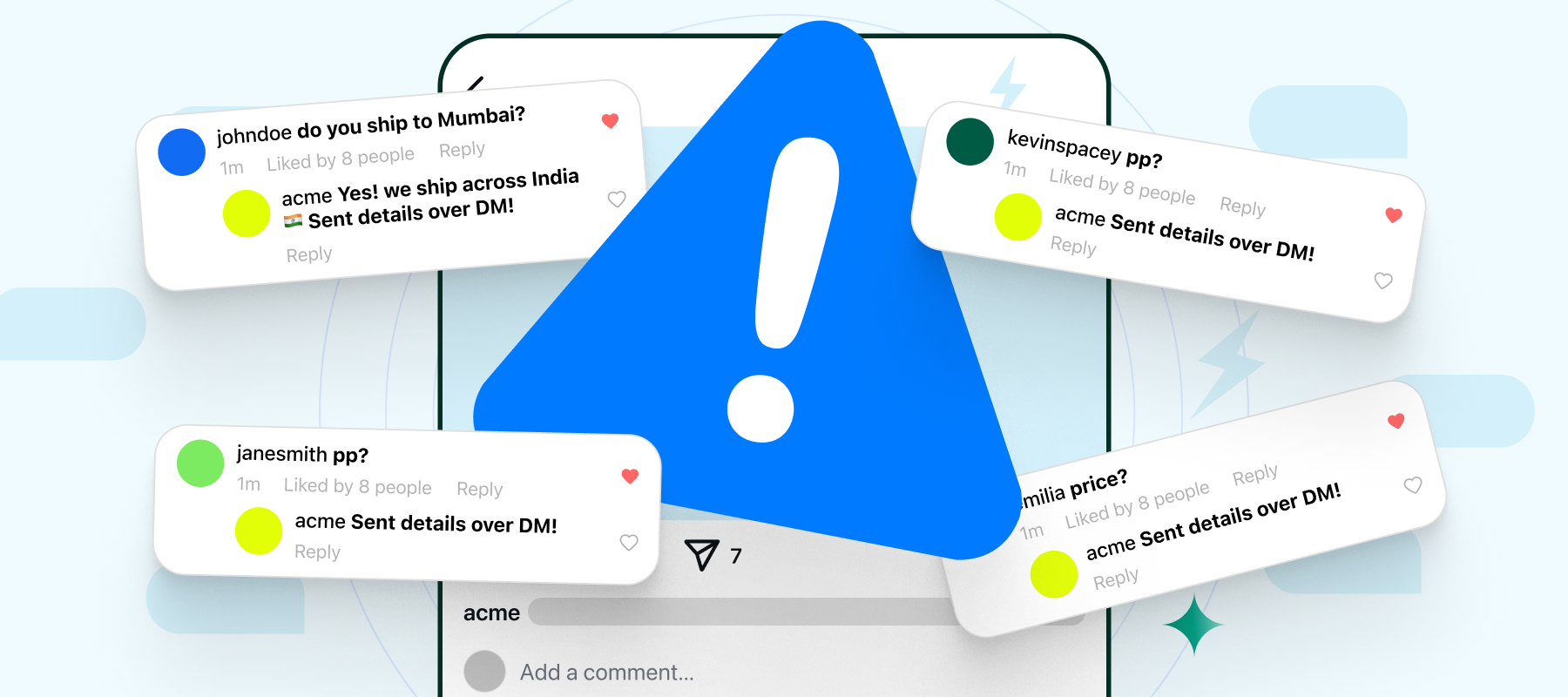If you’re using Instagram workflows, tracking ROI is the only way to know if they’re truly working.
Instagram automations can help you save time, streamline engagement, and drive growth, but without tracking return on investment (ROI), you cannot know what’s working for you and where you are burning time and money.
Measuring ROI gives you the clarity to make smarter, workflow-driven business decisions and adjust strategies to maximize real business value.
In this post, we’ll show you how to measure the ROI of your Instagram automation workflows so you can make smarter, data-driven business decisions.
Setting clear goals for Instagram workflows
Measuring ROI starts from defining what success looks like. When you have your goals aligned, you will know what you need to measure against and ensure they are met. Get started with setting targets around engagement, conversions, and revenue.
Engagement goals include metrics like response rates to automated DMs, comments generated from auto-replies, or growth in follower count. Conversion targets could focus on actions like link clicks, sign-ups, or purchases triggered from automated interactions. Revenue goals should be tied to the income generated from Instagram-sourced leads or sales.
Setting these targets early allows you to track progress meaningfully and connect automation efforts to business goals. Like, engagement metrics will help gauge how well your workflows are resonating with your audience, conversion metrics show their effectiveness, and revenue metrics show what’s bringing in business. Also, it’s important to align the workflows with business objectives like lead generation, customer service, product sales, or brand building, not vanity metrics like follower counts.
Let’s suppose your business goal is to boost online sales, your Instagram automation should drive product inquiries or send purchase links directly in DMs. Contrarily, if the objective is to get email sign-ups, your workflows should make it easy for followers to sign up.
Key metrics to measure Instagram workflow performance
Now that you have your goals aligned, here are the key metrics that best support your goals:
Customer engagement rate
Customer engagement rate is a deep dive into the audience’s interactions with your automated workflows, i.e., posts or messages. A higher engagement rate means your workflows are grabbing attention and evoking interactions and better customer relationships.
Aim for actions that include likes, shares, comments on posts, or replies to automated DMs, the indicators of strong engagement.
Conversion tracking
Workflows are responsible for engaging customers and also converting them. Metrics like the DM-to-sale ratio and the number of leads generated through automated interactions show how effective the workflows are in converting leads to customers.
Customer support efficiency
Beyond sales, having a customer support workflow in IG automations helps. You need to measure the support flows for response time and resolution rate to ensure their efficiency. A fast response time and a high resolution rate mean the workflows are improving customer satisfaction and boosting brand reputation.
Tools and methods to measure Instagram ROI
Here’s how you can accurately measure the ROI of your Instagram workflows, along with the tools that support them:
Using Instagram insights and third-party analytics tools
Instagram Insights covers the most basic insights on engagement, reach, and audience behavior. You get to see the performance of your posts, stories, and automated interactions in real time.
But you can do so much more with a third-party analytics tool like Interakt. They provide IG automation solutions and help you track advanced metrics like DM conversions, customer journey, open rates, click-throughs, and sales that go beyond surface-level statistics. Combining native Instagram data with third-party tools will give you the most from analytics.
Integrating CRM and marketing automation platforms
If you want to make the most of IG automation and ensure they have an impact on business outcomes, you need to integrate with CRM and automation platforms like Interakt.
Linking Instagram leads and conversations directly to your CRM helps you track customer journeys from the first interaction to final purchase and ensure they are in sync with broader sales and customer service processes.
When everything is connected, it becomes much easier to attribute wins to specific workflows and continuously optimize for better performance.
Calculating ROI: A step-by-step guide
Here’s how you can calculate the actual return on investment (ROI) from your Instagram workflows:
Revenue generated vs. cost of Instagram automation tools
Start by calculating the total revenue generated directly from your Instagram workflows, i.e., through automated DMs, conversions, or IG campaigns performance.
Next, define the total costs associated with running your Instagram automations, i.e., subscription fees of automation tools, any agency or freelance support, and internal time spent managing and optimizing workflows.
Your basic ROI formula will look like this:
-ROI = (Revenue Generated – Cost of Tools and Resources) / Cost of Tools and Resources × 100
If your revenue significantly outweighs your costs, you’re right on track, otherwise, you must optimize your workflows or adjust your strategy.
Measuring customer lifetime value (CLV) from Instagram interactions
IG workflows are not just for the short run, but also are capable of adding long-term value, including Customer Lifetime Value (CLV). CLV is the total revenue you can expect to earn from a customer throughout their relationship with you.
A simple formula to calculate CLV is:
– CLV = (Average Purchase Value) × (Number of Purchases per Year) × (Average Customer Lifespan in Years)
Tracking CLV from Instagram-sourced leads gives you a much deeper insight into your automation ROI. It shows whether Instagram is bringing in one-time buyers or loyal customers who keep spending over time.
Optimizing workflows for better ROI
Here’s how you can use the data from measuring ROI and continuously improve your Instagram workflows:
Refining automation strategies based on analytics
Analytics breaks the news of which automations are working and what’s not. You must regularly review the metrics to identify patterns and areas for improvement. Like, if a workflow has strong engagement but weak conversion, it indicates your call-to-action isn’t impactful.
You can better optimize your automation strategies with these insights but taking steps like adjusting the timing of messages, tweaking the content of auto-replies, or reworking the customer journey to remove unnecessary steps and ensure the workflows are driving the highest possible ROI.
A/B testing different messaging styles
Another powerful way to optimize Instagram workflows is through A/B testing, where you put two versions of a message against each other and find which one performs better.
You can experiment with different greeting styles in DMs, or find a unique tone of voice for your automated responses (formal vs. friendly), and even experiment with different calls-to-action (like “Shop Now” vs “Learn More”) to understand what makes your clients tick.
Run these tests systematically, changing only one element at a time, and measure the impact on key metrics like click-through rates, conversion rates, and customer satisfaction. Keep at fine-tuning your workflows to find what works best for your audience and ROI.
Case study: Businesses achieving high ROI with Instagram automation
A great example of Instagram automation driving real results comes from Coding Stella, a leading online coding academy. By automating their Instagram DMs, optimizing them for price quote CTA order confirmations with Interakt, they streamlined communication and reduced manual workload significantly.
With smart use of automation, CodingStella saw a faster response time, a spike in followers from 500k to 511k+ in just one month, and 2-3 hours saved daily from manual replies, leading to better customer satisfaction and overall business growth.
Key takeaways and final tips for tracking ROI effectively
Here are some final tips for you to maximize your returns from IG automation:
Connect Instagram automation to your CRM
To track your lead behavior accurately and the long-term ROI, centralize your data by integrating IG automation tools with CRM. It helps you keep a tab on all your leads, right from first interaction to final purchase (and beyond), to make impactful discoveries and decisions.
Measure beyond the first interaction
IG ROI isn’t just about the initial click or conversation. You have to dive deeper into metrics that define customer retention and revenue, like LTV, as well as upsells, cross-sells, or repeat purchases, to gauge the impact of the automation tools.
Run periodic A/B tests
Tracking ROI is an ongoing process, rather than a one-off exercise, to help you make improvements. Regularly running A/B tests on different messaging styles, call-to-actions (CTAs), and automated flows helps you improve lead quality and increase conversion rates over time.
Even small changes can yield significant gains, and periodic testing ensures your workflows stay fresh, relevant, and aligned with audience interests.
Keep attribution models in check
Instagram interactions can also be a part of a larger customer journey for multiple leads. Multi-touch attribution tracks all the different touchpoints a lead interacts with before making a purchase, giving you a fairer and more complete understanding of how Instagram workflows contribute to the final outcome.
Report ROI in terms that matter to stakeholders
When presenting ROI results to leadership or clients, focus on metrics that directly impact business goals like revenue generated, cost savings achieved through automation, and improvements in customer support efficiency, because stakeholders care about tangible business outcomes.
Conclusion
If you need to scale using Instagram for business, we recommend equipping yourself with the right automation tools. That’s where Interakt comes in – get started today.



